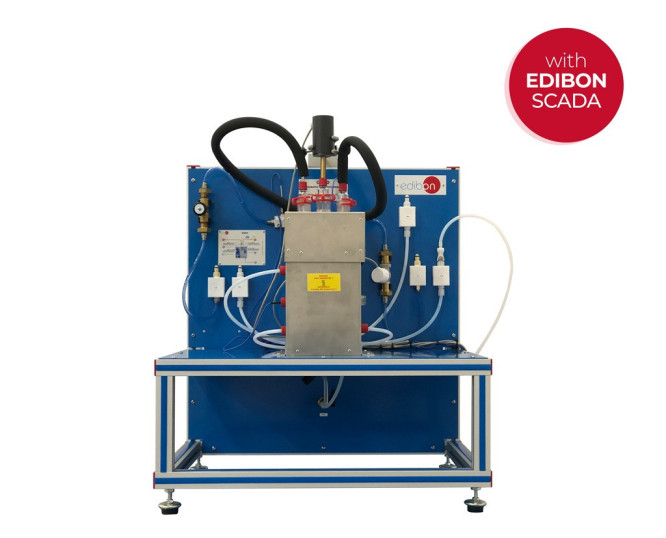QRAD Adiabatic and Isothermal Reactor
INNOVATIVE SYSTEMS
The Adiabatic and Isothermal Reactor, "QRAD", designed by EDIBON, is used as a calorimeter for the kinetic study of homogeneous liquid-liquid reactions. Characterized by maintaining a constant temperature with no heat exchange with the surroundings, this reactor ensures stable conditions during the process, which is essential for precise and reproducible research in the field of chemical and kinetic reactions.
Expansions
Laboratories
RELATED NEWS
General Description
The Adiabatic and Isothermal Reactor, "QRAD", designed by EDIBON, is used as a calorimeter for the kinetic study of homogeneous liquid-liquid reactions.
Characterized by maintaining a constant temperature with no heat exchange with the surroundings, this reactor ensures stable conditions during the process, which is essential for precise and reproducible research in the field of chemical and kinetic reactions.
This property guarantees that any temperature change within the reactor is solely attributable to the energy generated or absorbed by the reaction itself, without external influences, facilitating a more accurate assessment of reaction parameters and a better understanding of its kinetics and thermodynamic behavior.
The Adiabatic and Isothermal Reactor enables a wide range of practices, including the determination of ionic conductivities and the determination of reaction order with respect to different compounds, to the calculation of rate constants and the formulation of rate equations. Additionally, it allows the analysis of the variation of the rate constant with temperature through the Arrhenius equation, making comparisons between theoretical and experimental conversion, exploring the effect of concentration on conversion, calculating the heat transfer coefficient of the coil, and determining the enthalpy of specific reactions.
This versatility, which also includes the ability to study mixing effects and perform operations in both batch and continuous modes, makes this unit an indispensable tool for teachers and researchers in the field of chemical engineering and process engineering.
To work with this reactor, the Base and Service Unit, "QRUBI," is required, which supplies the necessary reagents and thermostatic water for proper operation.
These Computer Controlled Units are supplied with EDIBON Computer Control System (SCADA), and includes: The unit itself + a Control Interface Box + a Data Acquisition Board + Computer Control, Data Acquisition and Data Management Software Packages, for controlling the process and all parameters involved in the process.
Exercises and guided practices
GUIDED PRACTICAL EXERCISES INCLUDED IN THE MANUAL
- Determination of the ionic conductivities.
- Batch operation. Obtaining the reaction order with respect to the ethyl acetate. Method of initial rates.
- Bach operation. Obtaining the reaction order with respect to the sodium hydroxide. Method of initial rates.
- Batch operation. Calculation of the rate constant. Constant sodium hydroxide initial concentration.
- Batch operation. Calculation of the rate constant. Constant ethyl acetate initial concentration.
- Rate equation formulation.
- Batch operation. Variation of the kinetic constant with temperature. Arrhenius equation.
- Batch operation. Theoretical and experimental conversion comparison. Deviation from ideality.
- Batch operation. Effect of concentration on conversion.
- Calculation of the heat transfer coefficient of the coil.
- Batch operation. Mixing effects.
- Continuous operation.
- Sensors calibration.
MORE PRACTICAL EXERCISES TO BE DONE WITH THE UNIT
- Many students view results simultaneously. To view all results in real time in the classroom by means of a projector or an electronic whiteboard.
- Open Control, Multicontrol and Real Time Control. This unit allows intrinsically and/or extrinsically to change the span, gains, proportional, integral, derivate parameters, etc, in real time.
- The Computer Control System with SCADA and PID Control allow a real industrial simulation.
- This unit is totally safe as uses mechanical, electrical and electronic, and software safety devices.
- This unit can be used for doing applied research.
- This unit can be used for giving training courses to Industries even to other Technical Education Institutions.
- Control of the unit process through the control interface box without the computer.
- Visualization of all the sensors values used in the unit process.
- By using PLC-PI additional 19 more exercises can be done.
- Several other exercises can be done and designed by the user.
SUPPLEMENTARY EQUIPMENT
Base and Service Unit for QRQC
Isothermal Reactor with Stirrer
Isothermal Reactor with Stirrer and Distillation
Tubular Flow Reactor
Reactors with Stirrer in Series
Computer Controlled Chemical Reactors
Base and Service Unit for QRC
Computer Controlled Continuous Stirred Tank Reactor for QRC
Computer Controlled Tubular Flow Reactor for QRC
Computer Controlled Batch Reactor for QRC
Computer Controlled Stirred Tank Reactors in Series for QRC
Quality

AFTER-SALES SERVICE

 Cookie preferences
Cookie preferences


























